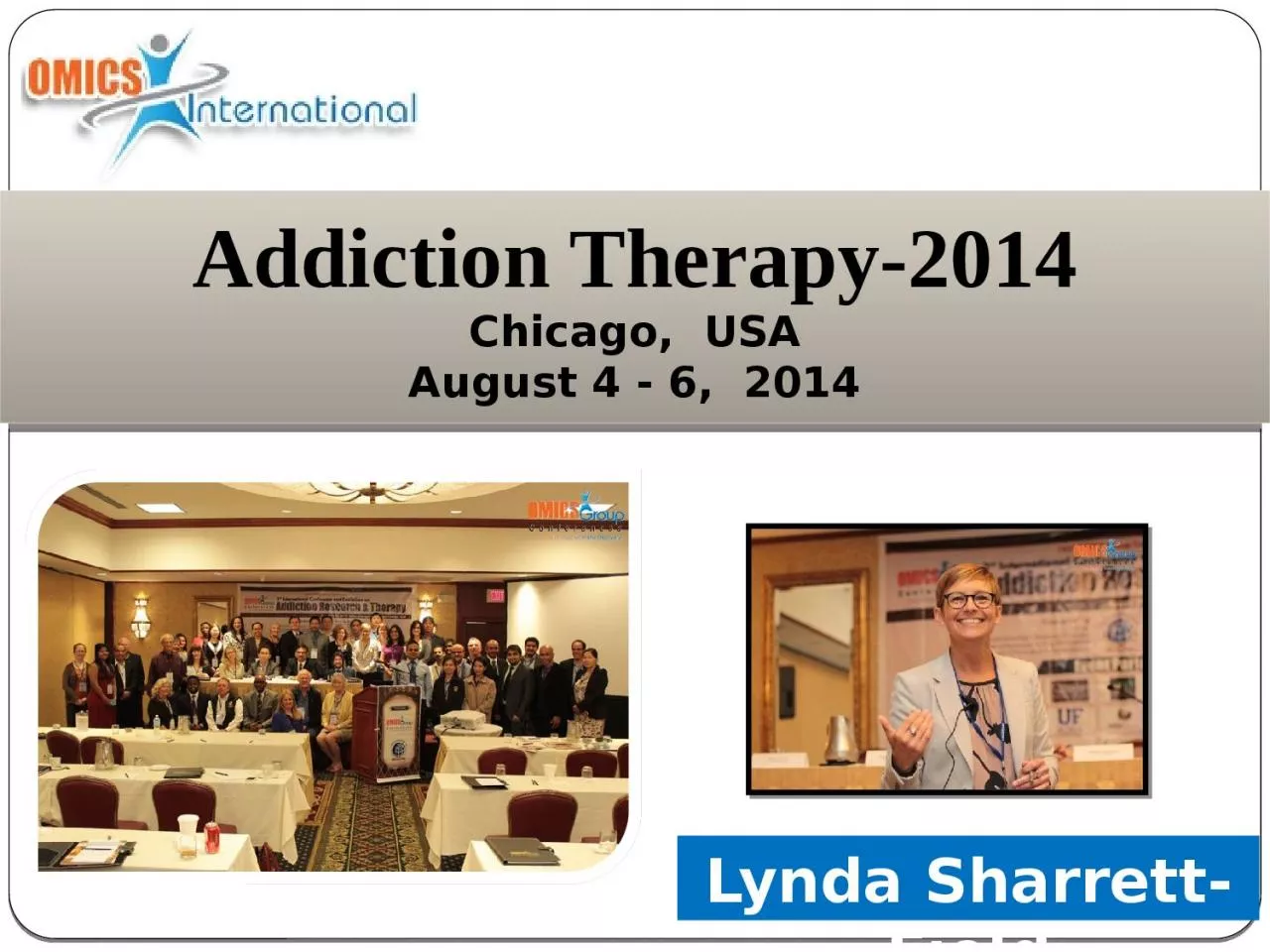

Chicago USA August 4 6 2014 Preclinical Studies of Glucocorticoid Receptor Antagonists in the Treatment of Alcohol Dependence Lynda SharrettField 1 Hilary J Little 2 Mark Prendergast ID: 933681
Download Presentation The PPT/PDF document "Lynda Sharrett-Field Addiction Therapy-2..." is the property of its rightful owner. Permission is granted to download and print the materials on this web site for personal, non-commercial use only, and to display it on your personal computer provided you do not modify the materials and that you retain all copyright notices contained in the materials. By downloading content from our website, you accept the terms of this agreement.
Slide1
Lynda Sharrett-Field
Addiction Therapy-2014Chicago, USAAugust 4 - 6, 2014
Slide2Preclinical Studies of Glucocorticoid Receptor Antagonists in the Treatment of Alcohol DependenceLynda Sharrett-Field1, Hilary J.
Little2 , Mark Prendergast1
1Department of Psychology, University of Kentucky, 2Division of Addictions, Institute of Psychiatry, University of London
Slide3AntabuseNaltrexoneVivitrolAcamprosateAlcohol WithdrawalBenzodiazepinesCurrent FDA Approved Treatments for Alcohol Dependence
Slide4HPA Axis and Addiction:Cortisol / CorticosteroneType 1: Mineralocorticoid receptors (MR)High affinityType 2: Glucocorticoid receptors (GR)Low affinityStress and Addiction
Slide5Preclinical Studies:Rats will self-administer CORT to physiological levels achieved with the presentation of stress. (Piazza et al, 1993)Administration of CORT increases self-administration of psychostimulants (Goeders, 1996)Administration of CORT or presentation of stressor increases self-administration of alcohol (Faulke et al, 1994)
Stress and Addiction
Slide6Potential Mechanism of CORT/DA InteractionSpanagel, Noori, Heilig, 2014
Slide7Voluntary Intermittent Ethanol Consumption and CORT
Basal plasma CORT levels are associated with voluntary EtOH Consumption
BELs and plasma CORT levels following 1hr of EtOH exposure are positively correlatedSharrett-Field et al., unpublished data
Slide8Elevations in corticosterone differ across brain regions and are affected by abstinence.Forced Continuous Ethanol Consumption and Corticosterone
3 week exposure ethanol via liquid diet
0
5
10
15
20
25
30
35
Corticosterone
ng/g
Hipp
Striatum Cortex
(Little
et al.,
2008)
Control
7% EtOH
3 weeks ethanol via liquid diet
6 days of abstinence
0
5
10
15
20
25
30
35
**
**
Hipp
Striatum Cortex
Corticosterone
ng/g
Control
7% EtOH
Slide9Ethanol withdrawal (EWD) induced neuronal damage reduced by RU486Organotypic hippocampal slice cultures
CORT (1uM)exposure during EWD resulted in significant loss of cells, which is reduced by GR antagonism.
Propidium iodide fluorescence(Mulholland et al., 2005)
ControlEWDCORT +EWDRU486 + CORT +EWD
Spironolactone + CORT +EWD20X5X
Slide10Glucocorticoid AntagonistsGR receptor antagonist:RU486 (Mifepristone)Termination of pregnancy (Progesterone receptor)Cushing’s SyndromeDepression with psychotic tendenciesCombat related PTSDORG34517 and ORG22189
Slide11Cognitive effects of EWD and exposure reduced by RU486
Behavior assessed 8-10 days following withdrawal from 34 weeks of chronic alcohol treatment in CJ57 mice
(Jacquot et al., 2008)Single administration of RU486 (
mif) prior to EWD reversed alcohol induced alterations on the object recognition task.
Slide12Behavioral effects of EWD reduced by RU486
4 day binge exposure:Ethanol administered via gavage 3 times dailyInjections of RU486 or vehicle given once daily prior to first daily ethanol dose
TremorSplayed pawsRigidity“Wet dog shakes” (Sharrett-Field et al., 2013)
Slide13Preference for alcohol is reduced by RU486
Low alcohol preferring mice
2 Bottle Choice:8% EtOH or tap waterOnce daily i.p. injectionSaline or RU486 (O’Callaghan et al, 2005)
0
2
4
6
8
10
12
14
16
18
20
0.0
0.1
0.2
0.3
0.4
0.5
0.6
Alcohol Preference Ratio
***
===
===
===
***
***
Day
Saline injections
RU486
injections
Slide14SummaryBasal levels of CORT are predictive of voluntary ethanol consumptionExposure to and withdrawal from chronic ethanol administration elevates levels of CORTElevations of CORT during EWD produces cell loss in the hippocampus, in vitro.Administration of RU486 during EtOH or EWD:Reduce cognitive deficitsReduce behavioral signs of EWDRU486 reduces ethanol preference
Slide15Human TrialsCo-Investigators- Hilary Little and Colin DrummondParticipantsAlcoholics entering Alcohol Treatment Units for detoxificationDSM-IV for 5 or more yearsMale aged 18-60 yearsRandomized double blind trialTreatmentRU486 or placebo given upon drinking cessation and for following two weeks12 month trialWeeks 1-4:Several assessments of withdrawal severityDepressive symptomology
Sleep disturbancesCognitive assessmentFollow-up at 3, 6, 12 monthsAbstinence & relapseDepressive symptomology
Slide16AcknowledgementsMark PrendergastNIAAAGrant: AA013388 & AA013561Hilary LittleNIAAAGrant: AA13932Medical Research Council
Slide17Addiction Therapy – 2015 Website:
addictiontherapy.conferenceseries.comMeet the eminent gathering once again at
Addiction Therapy-2015Florida, USAAugust 3 - 5, 2015